Bali Pass Trek: Exploring the Majestic Himalayan Trail
- Trekking Destinations
-
Jun 14
- Share post
Are you an adventurous soul seeking an extraordinary trekking experience? Look no further than the breathtaking Bali Pass trek.
Situated in the heart of the Indian Himalayas, this remarkable trail offers a perfect blend of natural beauty, thrilling challenges, and cultural immersion.
In this article, we will take you on a virtual journey through the Bali Pass trek, providing you with all the information you need to embark on this unforgettable adventure.
- Max Altitude: 16,240 Ft. (5,227M)
- Average Trekking Fees: INR 18,000 – INR 21,000
- Distance: 55 – 60 kms
- Difficulty: Difficult
- Duration: 8-9 days
- Ideal For: Experienced Trekkers Only
- Best Season: April – June & September – November
- Region: Uttarakhand
Table of Contents
ToggleOverview of the Bali Pass Trek
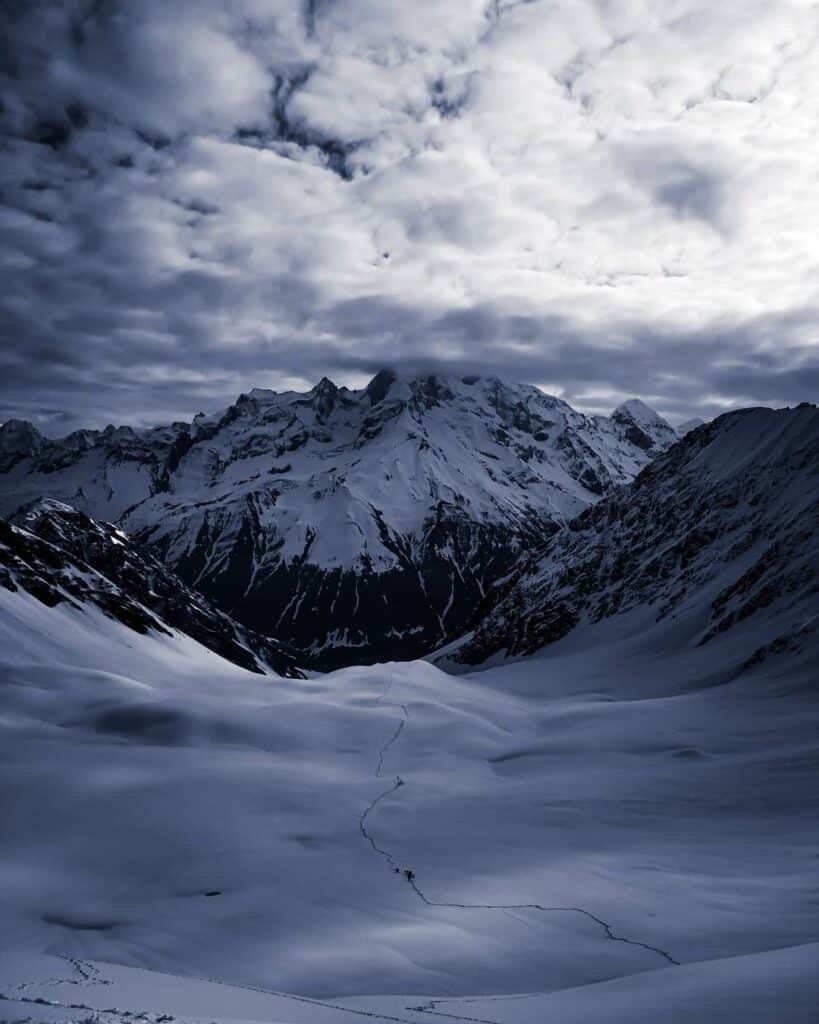
The Bali Pass Trek is a challenging and exhilarating trekking adventure in the Garhwal region of the Indian Himalayas. This high-altitude trek offers breathtaking views of snow-capped peaks, pristine alpine meadows, and dense forests, making it a popular choice among adventure enthusiasts.
The trek begins from the picturesque village of Sankri. It takes you through remote villages, gushing rivers, and dense pine forests. As you ascend higher, the landscape transforms into vast meadows adorned with colourful wildflowers and grazing sheep. The trail then leads to the base camp at Ruinsara, a beautiful lake surrounded by towering mountains.
From Ruinsara, the trek continues towards the Bali Pass, which sits at approximately 4,950 meters. This trek section requires careful navigation and involves crossing glaciers, steep slopes, and rocky terrains. However, the efforts are rewarded with awe-inspiring panoramic views of peaks like Swargarohini, Kalanag, and Bandarpoonch.
After conquering the pass, the descent begins, taking you through the remote villages of Yamunotri and Hanuman Chatti. The trek finally concludes at the holy town of Yamunotri, where you can dip in the natural hot springs to relax and rejuvenate.
The Bali Pass Trek is a challenging but immensely rewarding journey, offering a unique blend of natural beauty, cultural experiences, and a sense of accomplishment for those seeking an adventure in the Himalayas.
Additional Information For The Trek
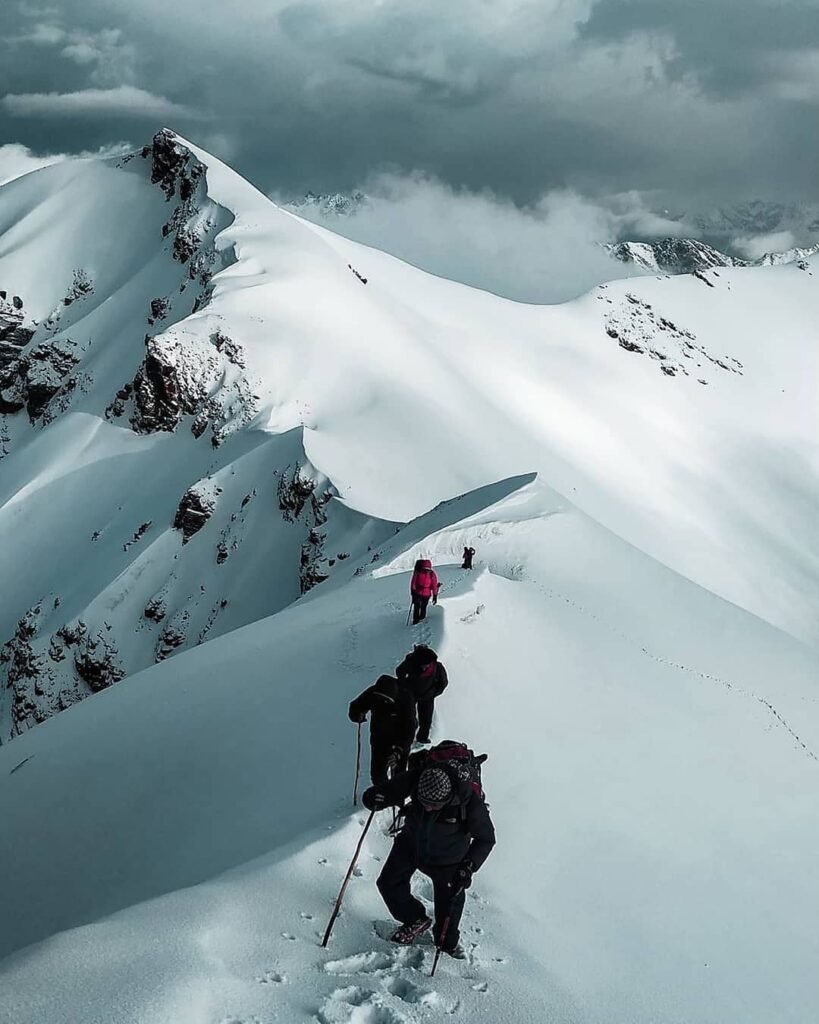
Bali Pass Trek Difficulty and Duration
The Bali Pass Trek is considered a difficult trek in terms of difficulty. It requires good physical fitness, as the trail involves steep ascents, descents, and navigating through rocky terrains and glaciers. The altitude gain and high altitude pass crossing further add to the challenge. Prior trekking experience and acclimatization are recommended for this trek.
In terms of duration, the Bali Pass Trek typically takes around 8 to 9 days to complete. This includes trekking, rest, and buffer days for acclimatization or unforeseen circumstances. The actual trekking days cover a distance of approximately 60 to 70 kilometres, depending on the route taken and variations in the itinerary.
It’s essential to follow a proper itinerary that allows for gradual acclimatization and sufficient rest to tackle the challenges of this demanding trek.
Best Time To Do The Bali Pass Trek
The best time to visit the Bali Pass Trek is from April to June (summer) and September to mid-November (autumn). These seasons offer favourable weather conditions and provide the region’s most suitable environment for trekking.
- April to June (summer):
The weather is relatively mild and pleasant during the summer months of April to June. The days are generally sunny, with temperatures ranging from 10°C – 20°C in the daytime. The nights may be chilly, with temperatures dropping to around 5°C – 10°C. The trekking trails are usually clear of snow, making navigating the terrain easier. The surrounding landscapes are vibrant, with blooming flowers, lush greenery, and picturesque views.
- September to mid-November (autumn):
The autumn season, from September to mid-November, is another excellent time to undertake the Bali Pass Trek. The weather during this period is stable, with clear skies and mild temperatures. Daytime temperatures range from 10°C to 15°C, while nighttime temperatures can drop to around 0°C to 5°C. The autumn months offer breathtaking views of the changing foliage as the forests transform into a palette of vibrant colours.
Both these seasons provide optimal trekking conditions with lesser chances of rainfall and clear visibility of the stunning Himalayan peaks.
Before commencing the trek, it is recommended to stay updated with the weather forecast and pack suitable clothing and gear to guarantee a pleasant and comfortable journey.
Costing & Budgeting
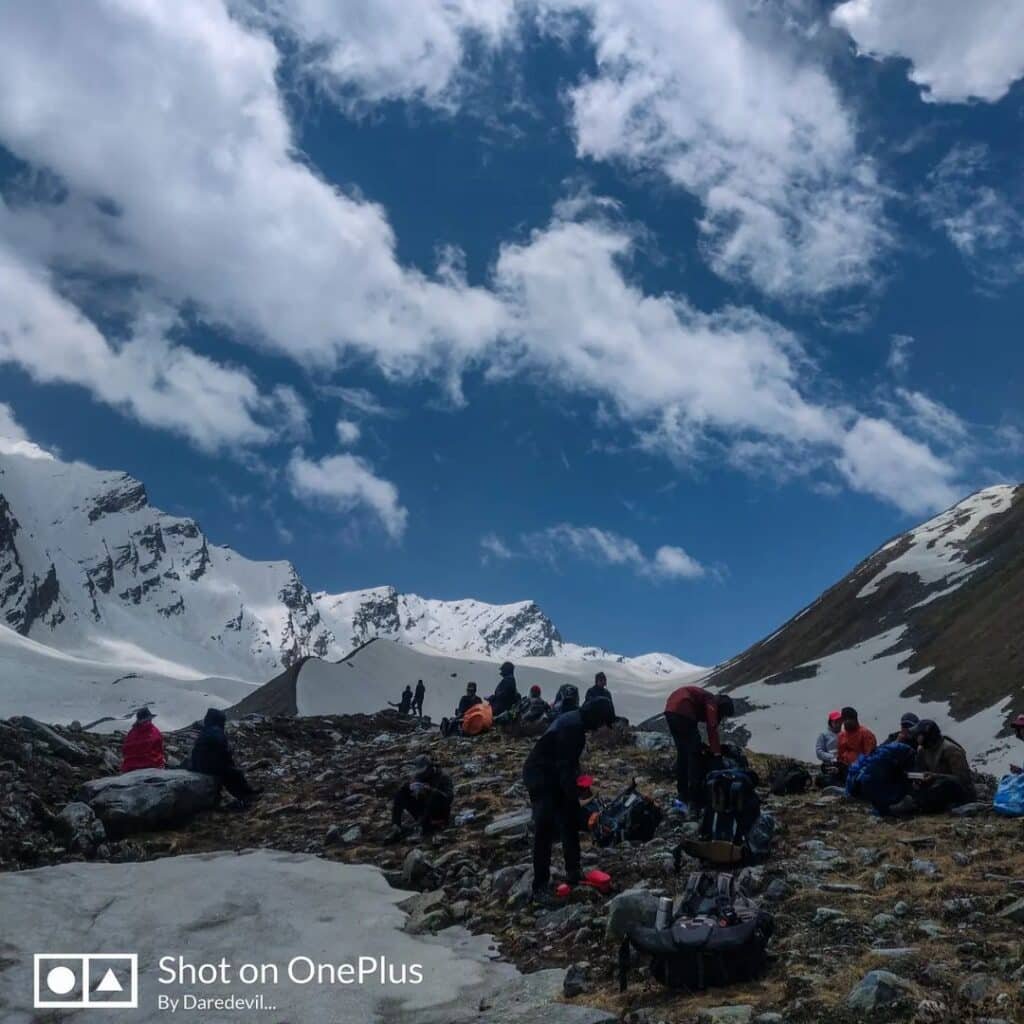
The cost and budget for the Bali Pass Trek can vary based on various factors, including the trek duration, transportation mode, and accommodation type and the inclusion of a trekking guide or porter services. However, as a general estimate, the overall cost for the trekking fees can range from INR 18,000 to INR 21,000 per person on average.
This cost usually includes permits, transportation from Dehradun to Sankri (the starting point of the trek), accommodation in guesthouses or tents during the trek, meals, and the services of a guide. Additional expenses may include equipment rentals, such as trekking poles, sleeping bags, and crampons if required.
It’s important to note that the cost mentioned above is a rough estimate and can vary depending on individual preferences and the service provider chosen. It is advisable to thoroughly research and compare prices from different trekking agencies or tour operators to find the best deal that suits your budget and requirements.
Additionally, it’s recommended to allocate a separate budget for personal expenses, such as travel insurance, snacks, extra meals, and any additional activities or sightseeing you may want to indulge in before or after the trek.
Proper planning and budgeting in advance will help ensure a smooth and enjoyable trekking experience within your desired budget range.
How To Reach?
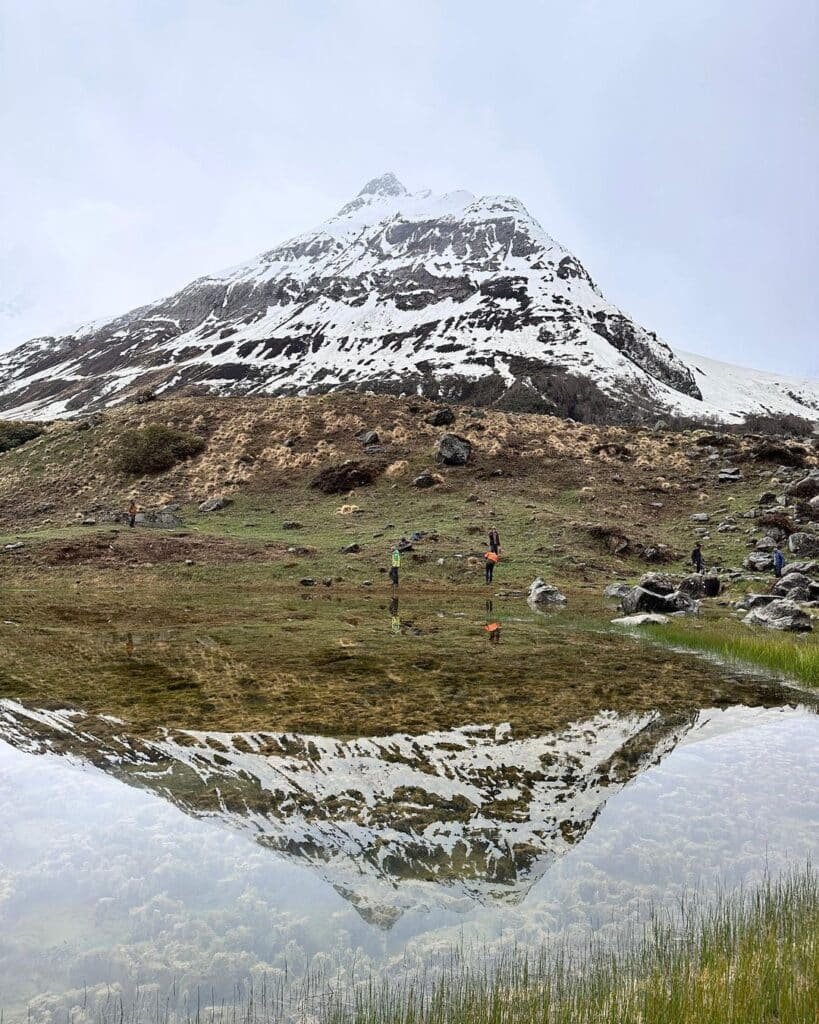
Sankri, the starting point of the Bali Pass Trek, is a small village located in the Garhwal region of Uttarakhand, India. While Sankri is not directly connected by air or train, it can be reached via air, road, and train travel.
- By Air: The nearest airport to Sankri is the Jolly Grant Airport in Dehradun, which is well-connected to major cities in India. One can take a private or shared cab to Sankri, approximately 200 kilometres away. The journey takes 8-10 hours, passing through scenic landscapes and picturesque towns.
- By Road: Sankri is accessible from Dehradun, the closest major city. Regular buses and shared taxis operate from Dehradun to Sankri. The road journey takes around 8-10 hours, depending on the traffic and road conditions. Private taxis or public buses can also be hired from Dehradun for a more comfortable and convenient travel experience.
- By Train: The nearest railway station to Sankri is Dehradun Railway Station, which is well-connected to major cities in India. From the railway station, one can take a bus or a taxi to reach Sankri via road, as mentioned above.
It’s important to note that road conditions in the region can be challenging, especially during the monsoon season. It is advisable to check the weather and road conditions beforehand and plan the travel accordingly.
Detailed Trek Itinerary

Day 1: Arrival in Sankri
Upon arrival in Sankri, a picturesque village in Uttarakhand, you will meet your trekking team and rest for the day. Sankri is surrounded by beautiful forests and offers a glimpse of traditional Himalayan culture.
Day 2: Sankri to Seema via Taluka (12 KM | 7-8 Hours)
Embark on your trek from Sankri to Seema with a stopover at Taluka. The route guides you amidst lush woodlands and captivating rural settlements, offering scenic views of the Har Ki Dun Valley. Highlights of the day include picturesque landscapes, gushing rivers, and the warmth of local hospitality.
Day 3: Seema to Devsu Bugyal (10 KM | 5-6 Hours)
Continue your trek from Seema to Devsu Bugyal. As you ascend, you’ll be greeted with expansive meadows adorned with vibrant flowers and panoramic views of snow-capped peaks. Devsu Bugyal showcases the beauty of high-altitude grasslands and offers a tranquil camping experience.
Day 4: Devsu Bugyal to Ruinsara Tal (7 KM | 4-5 Hours)
Trek from Devsu Bugyal to Ruinsara Tal, a breathtaking high-altitude lake surrounded by towering mountains. The route provides stunning views of the Himalayas and offers opportunities for birdwatching. Camping near the serene lake is a highlight of the day, providing a peaceful ambience amidst nature’s splendour.
Day 5: Ruinsara Tap to Odari (4KM | 3-4 Hours)
Resume your trek from Ruinsara Tal to Odari, a picturesque location known for its beautiful meadows and wildflowers. The trail takes you through alpine forests, providing glimpses of wildlife and offering a serene atmosphere for relaxation and rejuvenation.
Day 6: Odari to Bali Pass Camp (5 KM | 6-7 Hours)
Today’s trek takes you to the Bali Pass Camp, situated at the base of the Bali Pass. The campsite offers stunning views of the surrounding peaks and prepares you for the exciting challenges ahead. Enjoy the beauty of the campsite and gear up for the next day’s adventure.
Day 7: Bali Pass Camp to Lower Damini via Bali Pass (14 KM | 10-11 Hours)
The highlight of the trek arrives as you cross the challenging Bali Pass at an altitude of approximately 4,800 meters. The pass rewards you with breathtaking views of the Himalayas and an immense sense of accomplishment. Descend to Lower Damini and camp amidst the serene surroundings.
Day 8: Lower Damini to Jana ki Chatti & drive to Dehradun (8 KM | 4-5 Hours)
The final day of the trek involves a descent to Jana ki Chatti. From there, you’ll drive back to Dehradun, marking the end of your adventurous journey. Reflect on the unforgettable experiences and cherish the memories of the Bali Pass Trek.
The Bali Pass Trek itinerary offers a perfect blend of natural beauty, challenging terrain, serene camping spots, and breathtaking mountain vistas. Each day brings unique highlights and experiences that will make your trek unforgettable in the Himalayas.
Highlights of the Bali Pass Trek
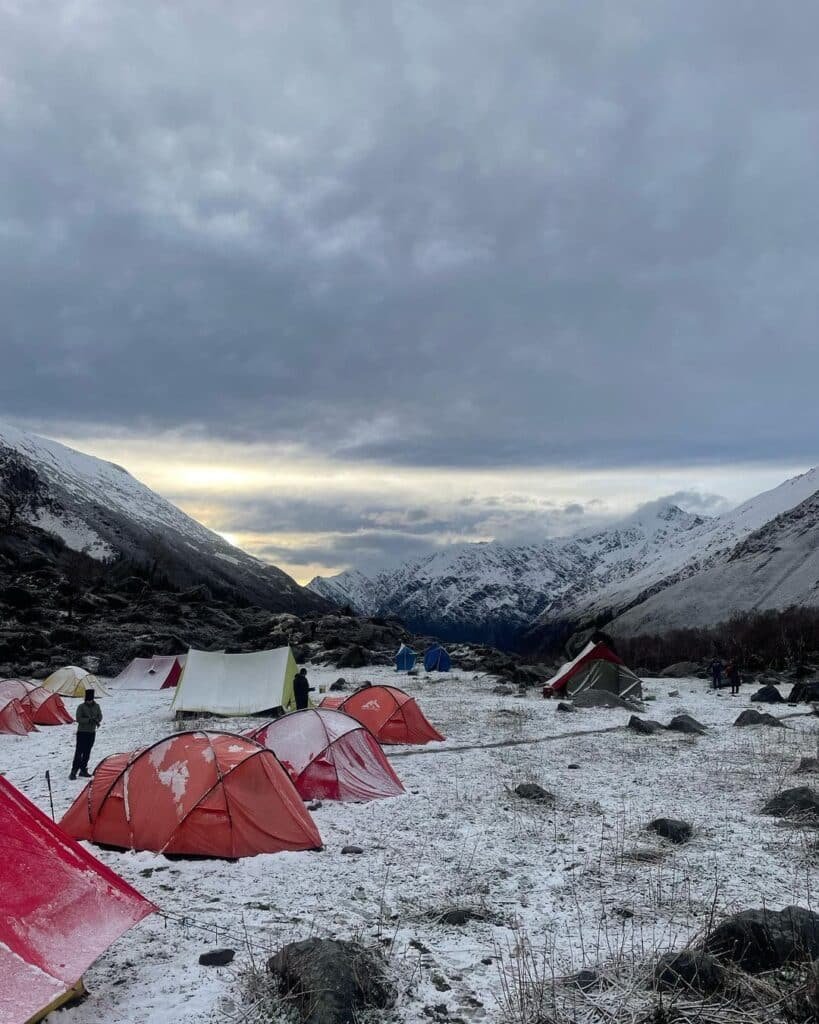
- Scenic Beauty: The Bali Pass Trek offers stunning panoramic views of the majestic Himalayan peaks, including Swargarohini, Kalanag, and Bandarpoonch. The picturesque landscapes of alpine meadows, dense forests, and gushing rivers create a visual treat for trekkers.
- Challenging Pass Crossing: Crossing the Bali Pass at an altitude of 4,800 meters is a thrilling and rewarding experience. The pass involves navigating through glaciers, steep slopes, and rocky terrains, providing trekkers with a sense of accomplishment and adventure.
- Pristine Lakes: The trek takes you to the enchanting Ruinsara Tal, a serene high-altitude lake surrounded by snow-capped mountains. The crystal-clear waters and the reflection of the surrounding peaks create a tranquil and awe-inspiring atmosphere.
- Cultural Immersion: The trek offers an opportunity to interact with the local villagers, providing insights into their unique culture and way of life. The quaint villages along the trail, with their traditional houses and warm hospitality, add a cultural charm to the trek.
- Remote and Offbeat Trail: The Bali Pass Trek is known for its offbeat and less crowded trail. Trekking through remote villages, untouched landscapes, and pristine wilderness offers a sense of solitude and a chance to connect with nature on a deeper level.
- Personal Growth: The Bali Pass Trek challenges your physical endurance, mental resilience, and navigation skills. It pushes you out of your comfort zone, fostering personal growth, self-discovery, and a stronger bond with your fellow trekkers.
Fitness Requirement & Preparation for the Trek
The Bali Pass Trek is a challenging adventure that demands good physical fitness and mental preparedness. Being adequately prepared and physically capable is essential to have a safe trek. Here are some important considerations for fitness and preparation:
Physical Fitness: The trek involves long hours of walking on steep ascents, descents, rocky terrains, and high altitudes. Prior cardiovascular exercise like running or cycling can help build endurance and improve stamina. Strength training exercises focusing on the lower, core, and upper body will aid in tackling the demanding trail.
Acclimatization: The trek reaches high altitudes, which is crucial to avoid altitude sickness. Gradual ascent, regular hydration, and listening to your body are vital. It is recommended to undergo a few days of acclimatization in Sankri or nearby areas before starting the trek.
Mental Preparedness: Trekking in challenging terrains requires mental resilience. Be prepared for long hours of walking, unpredictable weather conditions, and staying in basic accommodations. A positive mindset, determination, and flexibility are key to overcoming obstacles and enjoying the journey.
Packing Essentials: Prepare a comprehensive packing list, including proper trekking gear, warm clothing, sturdy trekking boots, a comfortable backpack, a sleeping bag, and essential personal items. Consult with a trekking expert or tour operator for a detailed checklist.
Training and Preparation:
- Engage in regular physical exercise and outdoor activities to improve endurance, strength, and balance.
- Practice hikes with a backpack to get accustomed to the weight and terrain.
- Familiarize yourself with basic first-aid techniques and survival skills.
Medical Check-up:
- Before the trek, consult a healthcare professional for a thorough medical check-up.
- Discuss any pre-existing medical conditions and medications to ensure they won’t pose a risk during the trek.
- Carry necessary medications and a basic first aid kit.
By focusing on physical fitness, mental preparedness, and thorough planning, you can make the most of your Bali Pass Trek experience. Remember to start your preparations well in advance and enjoy the journey while being mindful of your limitations and safety.
Essential Gear and Equipment for Bali Pass Trek
Before embarking on the trek, it is essential to pack the right gear and equipment to ensure a safe and comfortable journey. Here is a list of items you should consider carrying:
- Trekking shoes with good ankle support
- Backpack with rain cover
- Trekking gaiters
- Warm and waterproof clothing layers
- Sleeping bag suitable for sub-zero temperatures
- Trekking poles for better stability on uneven terrains
- UV-protected sunglasses and sunscreen
- Water bottles and water purification tablets
- Headlamp or flashlight with extra batteries
- First aid kit with essential medications
- Portable power bank for charging electronic devices
Safety Tips & Precautions
While embarking on any trek, safety should always be a top priority. Here are some essential safety tips to keep in mind during the Bali Pass Trek:
- Trek with an experienced guide and follow their instructions.
- Stay hydrated and carry an adequate supply of water.
- Pack light and carry only the essential items.
- Dress in layers to adapt to changing weather conditions.
- Respect the environment and maintain cleanliness.
- Inform someone about your trekking plans and expected return.
- Stay updated about weather conditions and local regulations.
- Avoid alcohol and smoking during the trek.
Conclusion
The Bali Pass trek is an extraordinary adventure that promises to leave you spellbound. From the rugged terrains to the serene valleys, this trek offers diverse experiences that will stay etched in your memory forever.
Embark on this remarkable journey, challenge yourself, and discover the hidden treasures of the Himalayas.
Get ready for an unforgettable experience that will ignite your sense of adventure and bring you closer to the raw beauty of nature.
FAQs
Yes, the Bali Pass Trek is considered a challenging trek. It requires a good level of physical fitness and prior trekking experience.
The Bali Pass Trek is located in the state of Uttarakhand, India.
The Bali Pass summit is approximately 5,227 meters (16,240 feet) above sea level.
Yes, there can be snow on the Bali Pass in September. However, the presence of snow can vary depending on weather conditions and the specific year. It is advisable to check with local authorities or trekking agencies for the latest information and to be prepared to encounter snow.
Comments
Add a comment
Leave a Reply · Cancel reply
This site uses Akismet to reduce spam. Learn how your comment data is processed.
